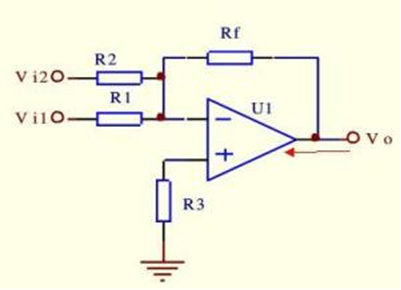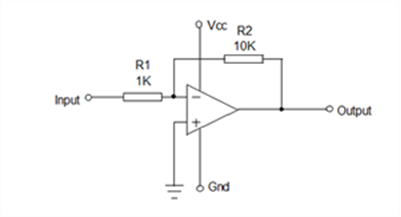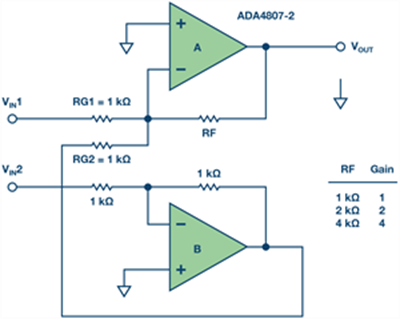- English
-
EnglishDeutschItaliaFrançais한국의русскийSvenskaNederlandespañolPortuguêspolskiSuomiGaeilgeSlovenskáSlovenijaČeštinaMelayuMagyarországHrvatskaDanskromânescIndonesiaΕλλάδαБългарски езикGalegolietuviųMaoriRepublika e ShqipërisëالعربيةአማርኛAzərbaycanEesti VabariikEuskeraБеларусьLëtzebuergeschAyitiAfrikaansBosnaíslenskaCambodiaမြန်မာМонголулсМакедонскиmalaɡasʲພາສາລາວKurdîსაქართველოIsiXhosaفارسیisiZuluPilipinoසිංහලTürk diliTiếng ViệtहिंदीТоҷикӣاردوภาษาไทยO'zbekKongeriketবাংলা ভাষারChicheŵaSamoa日本語SesothoCрпскиKiswahiliУкраїнаनेपालीעִבְרִיתپښتوКыргыз тилиҚазақшаCatalàCorsaLatviešuHausaગુજરાતીಕನ್ನಡkannaḍaमराठी
E-mail:Info@YIC-Electronics.com
Fundamentals of Op-Amp Circuits
In the intricate world of electronics, a journey into its mysteries invariably leads us to a kaleidoscope of circuit components, both exquisite and complex. At the heart of this realm stand operational amplifiers (op amps), celebrated for their remarkable versatility and broad spectrum of applications. Ranging from the elementary voltage buffer to the more sophisticated realms of negative resistor applications, these configurations of op amps unfurl the intricate principles of electronic circuit design, along with a plethora of applications. Our article aims to delve deeply into these diverse configurations of operational amplifiers. We will dissect their characteristics, scrutinize their principles, and illuminate the practical applications of each circuit design. This exploration is intended to bestow a richer, more profound understanding of this pivotal electronic component. Embarking with the rudiments of voltage buffers, we will navigate through the labyrinth of more complex circuit designs, thereby unveiling the op amps' diversity and indispensable role in the fabric of modern electronics.

Voltage Buffers
In the foundational lessons of electronics, we frequently encounter a component that seems deceptively straightforward yet is fundamentally crucial: the voltage buffer. Its principle is crisp and direct – the output voltage mirrors the input voltage. This apparent simplicity may leave beginners puzzled, doubting its practical utility. However, the essence of a voltage buffer is in its capability to forge a high-impedance input alongside a low-impedance output, an attribute indispensable in electronic circuit design. Consider the scenario where two electronic components need interlinking, yet their resistive properties clash. Here, the voltage buffer emerges as a savior. Equally, its significance is accentuated in circuits reliant on voltage dividers. Absent a buffer, such dividers might succumb to the whims of load impedance fluctuations, leading to output voltage instability. The insertion of a voltage buffer between the load and the divider is a strategic move, essential in ensuring output voltage stability, particularly in advanced applications where precision in voltage control is paramount.

The Inverting Op Amp, a Study in Contrasts
Now, let's pivot to the intriguing world of inverting operational amplifiers. In this configuration, the output signal, in a dance of inverses, finds its way to the op amp's negative input via a feedback resistor (R2). This design choreographs an output signal that is in antiphase with the input signal. It becomes particularly evident when R1 and R2 mirror each other in value, resulting in an output signal whose phase diametrically opposes the input signal, crafting a complementary signal. Such a feature proves invaluable in applications demanding phase inversion of signals, like in the nuanced realms of audio signal processing or signal modulation. Standing apart from non-inverting amplifiers, inverting amplifiers offer a streamlined approach to achieving an output that is the antithesis in phase to the input signal, thus carving a unique niche in electronic circuit design.

The Non-Inverting Op Amp
Shifting the focus to the non-inverting op amp, we observe a design that echoes its inverting counterpart, yet with a pivotal distinction: the input signal is applied unmediated to the non-inverting pin, while the feedback loop's terminus is anchored to the ground. This configuration ensures the output signal remains in harmony with the input signal's phase. This is particularly advantageous in contexts where amplification of a signal is desired without a phase shift. Whether it's processing analog signals or crafting a basic audio amplifier, the non-inverting op-amp presents itself as a straightforward yet effective solution.
Non-Inverting Summing Amplifiers
Advancing in our journey, we turn our lens to the non-inverting summing amplifier. This circuit ingeniously enables the amalgamation of two voltages simply by appending two resistors to the positive pin of the non-inverting op-amp. While this method exudes simplicity, it reveals certain constraints when tasked with handling multiple signals. Consider the challenge of summing three voltages with identical resistance values; the output voltage's calculation formula becomes convoluted, potentially clashing with design intentions. Here, the quest for more adaptable voltage summation might necessitate a recalibration of resistor values or a strategic pivot to the realm of inverting summing amplifiers.
The Inverting Summing Amplifier
Contrasting its non-inverting counterpart, the inverting summing amplifier adeptly accomplishes the superposition of multiple voltages. This is achieved by integrating a resistor in parallel to the inverting input pin. The configuration's strength lies in its ability to accommodate an arbitrary number of voltages without necessitating alterations in resistor values, thus demonstrating formidable adaptability and flexibility in complex circuit designs that demand the handling of multiple signal inputs.

Differential Amplifiers
The differential amplifier emerges as an evolution of the inverting op-amp, enriched by the integration of a voltage divider on the non-inverting pin. This ingenious configuration empowers the amplifier to process signals emanating from two distinct inputs and output their differential. Particularly instrumental in scenarios requiring precise measurement of signal disparities, such as in the nuanced domain of sensor data processing or audio signal manipulation, the differential amplifier stands as a testament to functional design.

Integrator Circuits
Next, our exploration leads us to the realm of integrator circuits. These circuits adeptly generate triangular waveforms by integrating input signals. At their core lie an op-amp, a capacitor joined to the inverting feedback path, and a resistor connected to the inverting input pin. This configuration shines in its efficacy when dealing with digital signals, like square waves. Yet, a word of caution: to avert circuit saturation, especially when encountering low-frequency signals, capacitors are typically paralleled with resistors, a measure ensuring the circuit's equilibrium and stability.

Differentiators
In a parallel vein to integrators, differentiators achieve their purpose by artfully exchanging the roles of capacitors and resistors. Their prowess is unveiled in handling signals that evolve at breakneck speeds, finding their niche in the sophisticated arenas of signal processing and instrument calibration.
Current-to-Voltage Converters
Moving forward, we delve into the design of current-to-voltage converters. This circuit adeptly transforms the current produced by photodetectors into voltage, orchestrated through an op amp, a feedback loop via a non-inverting resistor, and a diode bridging the two input pins. Tailor-made for the processing of optoelectronic signals, this design finds its calling in the realms of photodetection and optical communication.
Negative Resistance
Lastly, we explore the intriguing concept of negative resistance. In select op amp circuits, feedback on the inverting pin can double the input voltage as output. This ingenious configuration mimics the effect of negative resistance, a boon in advanced circuit designs such as specialized signal processing or peak detection circuits.
Through this in-depth exploration, we not only bolster our understanding of operational amplifiers but also illuminate their vast versatility and pivotal role in electronic circuit design. Each configuration, with its unique functionality and application scenarios, unravels the tapestry of electronics' wonder and complexity. Through such detailed analysis and discourse, we deepen our grasp of these foundational electronic components, showcasing their expansive utility and significance in practical circuit design. From the unassuming voltage buffer to the intricate negative resistor applications, every configuration narrates its distinct story, echoing the depth and expansiveness of electronics. These designs are not mere academic curiosities for novices but vital instruments in the arsenal of professional circuit designers. In summation, operational amplifiers and their multifarious configurations are the harbingers of ceaseless innovation and progress in electronics, playing a crucial role in propelling technological advancements and fulfilling the diverse needs of contemporary society.
Related Blog
-
Fundamentals of Op-Amp Circuits
December 28th, 2023
In the intricate world of electronics, a journey into its mysteries invariably leads us to a kaleidoscope of circuit components, both exquisite and co... -
How Many Zeros in a Million, Billion, Trillion?
July 29th, 2024
Million represents 106, an easily graspable figure when compared to everyday items or annual salaries. Billion, equivalent to 109, starts to stretch t... -
Comprehensive Guide to SCR (Silicon Controlled Rectifier)
April 22th, 2024
Silicon Controlled Rectifiers (SCR), or thyristors, play a pivotal role in power electronics technology because of their performance and reliability. ... -
CR2032 lithium-ion battery: multi-scenario applications and its unique advantages
January 25th, 2024
The CR2032 battery, a commonly used coin-shaped lithium-ion battery, is essential in many low-power electrical products such as digital watches and po... -
NPN and PNP Transistors
December 28th, 2023
For exploring the world of modern electronic technology, understanding the basic principles and applications of transistors is essential. Although the... -
What is a thermistor
December 28th, 2023
In the realm of modern electronic technology, delving into the nature and working mechanism of thermistors becomes a crucial endeavor. These precision... -
Explore the Difference Between PCB and PCBA
April 16th, 2024
A PCB serves as the backbone of electronic devices. Made from a non-conductive material, it physically supports components while also connecting them ... -
BC547 Transistor Comprehensive Guide
July 4th, 2024
The BC547 transistor is commonly used in a variety of electronic applications, ranging from basic signal amplifiers to complex oscillator circuits and... -
What Is A Solenoid Switch
December 26th, 2023
When an electrical current flows through the coil, the resulting magnetic field either attracts or repels the iron core, causing it to move and either... -
IRLZ44N MOSFET Datasheet, Circuit, Equivalent, Pinout
August 28th, 2024
The IRLZ44N is a widely-used N-Channel Power MOSFET. Renowned for its excellent switching capabilities, it is highly suited for numerous applications,...
Hot Parts
- AD9214BRSZ-105
- PSMN045-80YS
- LV5124T-TLM-E
- SY88149CLEYTR
- GRM0335C1E1R5CD01J
- SI2493-FS
- MSM7533VGS
- CD74AC646M96
- BC41C671A-IPK-E4
- MMPQ3906R2
- MSB2320-LF
- GRM1555C1E1R4CA01D
- LT1768CGN#PBF
- GRM3197U2A511JZ01D
- MB86H610HPB-6F1T-GE1
- MM1323XV
- TC4427ACOA
- XC9572-7TQG100C
- HIN232ECBZ-T
- S5C-215HVS
- 0805ZD684KAT2A
- PEX8524-BC25VBIG
- SST89E54RD2A-40-C-NJE
- RMLV0416EGSB-4S2
- CEU3E2X7R1H472M080AE
- B0505LS-1WR3
- SY10EP52VKGTR
- 02013A330JAT2A
- UCC3803DTR
- N82802ABB
- F930J686KCC
- TPS40195PW
- ADA4430-1YKSZ
- EFM32G890F128-BGA112
- 08051C153JAT2A
- MSP3425G-QA-B8-V3
- PXB4221EV3.3
- MAX13003EEUE
- PSB6972HLV1.3
- VI-J40-CZ
- ICS95431CGLFT
- X28HC64JM-20
- VY22475-
- LM107J-8/883
- XCS40PQ208-4C
- DAC80508ZRTET
- AMPAL22V10PC
- 2225HC332KAT3A












